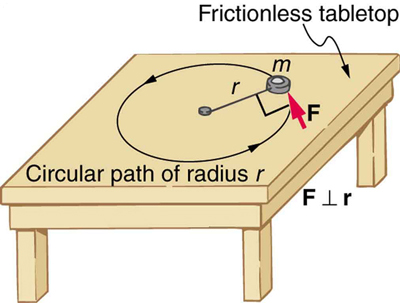| << Chapter < Page | Chapter >> Page > |
or
This last equation is the rotational analog of Newton's second law ( ), where torque is analogous to force, angular acceleration is analogous to translational acceleration, and is analogous to mass (or inertia). The quantity is called the rotational inertia or moment of inertia of a point mass a distance from the center of rotation.

Dynamics for rotational motion is completely analogous to linear or translational dynamics. Dynamics is concerned with force and mass and their effects on motion. For rotational motion, we will find direct analogs to force and mass that behave just as we would expect from our earlier experiences.
Before we can consider the rotation of anything other than a point mass like the one in [link] , we must extend the idea of rotational inertia to all types of objects. To expand our concept of rotational inertia, we define the moment of inertia of an object to be the sum of for all the point masses of which it is composed. That is, . Here is analogous to in translational motion. Because of the distance , the moment of inertia for any object depends on the chosen axis. Actually, calculating is beyond the scope of this text except for one simple case—that of a hoop, which has all its mass at the same distance from its axis. A hoop's moment of inertia around its axis is therefore , where is its total mass and its radius. (We use and for an entire object to distinguish them from and for point masses.) In all other cases, we must consult [link] (note that the table is piece of artwork that has shapes as well as formulae) for formulas for that have been derived from integration over the continuous body. Note that has units of mass multiplied by distance squared ( ), as we might expect from its definition.
The general relationship among torque, moment of inertia, and angular acceleration is
or
where net is the total torque from all forces relative to a chosen axis. For simplicity, we will only consider torques exerted by forces in the plane of the rotation. Such torques are either positive or negative and add like ordinary numbers. The relationship in is the rotational analog to Newton's second law and is very generally applicable. This equation is actually valid for any torque, applied to any object, relative to any axis.
As we might expect, the larger the torque is, the larger the angular acceleration is. For example, the harder a child pushes on a merry-go-round, the faster it accelerates. Furthermore, the more massive a merry-go-round, the slower it accelerates for the same torque. The basic relationship between moment of inertia and angular acceleration is that the larger the moment of inertia, the smaller is the angular acceleration. But there is an additional twist. The moment of inertia depends not only on the mass of an object, but also on its distribution of mass relative to the axis around which it rotates. For example, it will be much easier to accelerate a merry-go-round full of children if they stand close to its axis than if they all stand at the outer edge. The mass is the same in both cases; but the moment of inertia is much larger when the children are at the edge.

Notification Switch
Would you like to follow the 'College physics for ap® courses' conversation and receive update notifications?